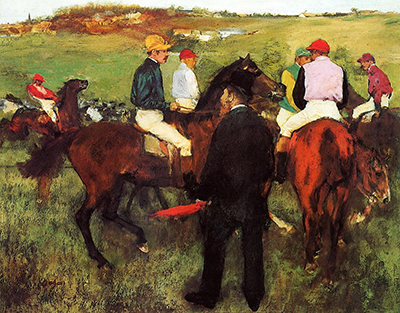Edgar Degas' fascination with ballerinas could only be met with his admiration for horses. The talented artist spent a great deal of time watching horse races just outside of Paris. The luxurious sport was for the upper class, where Degas was lucky enough to be a spectator.
The stunning painting is created in a classic impressionistic style, even though Degas often argued that his work was realist. Alongside, this is one the pieces apart from a small collection of scenic pieces Degas created. The artist was more transfixed by manifesting onto canvas the events that occurred indoors, rather than the outside world. Some of his contemporaries Pierre-Auguste Renoir and Claude Monet often preferred marvellous paintings of nature. The painting showcases a group of men huddled together as they prepare to race their horses on the beautiful meadow. While the viewer can easily distinguish the characters throughout the piece, some of the other aspects are blended into one another lacking exquisite detail.
Degas was a brilliant artist able to capture the viewer's attention towards any aspect of his painting. This is done in Racehorses At Longchamp as he brings the viewer's attention towards the man near the centre in the yellow hat. By analyzing the painting, it'ss evident that most of the men have a red hat on, apart from a man hidden wearing a green hat. Yet, the man in the yellow hat is shown most clearly within the piece, alongside his horse. These men are dressed in colourful polo shirts in hues of emerald green, light pink, sorbet red, baby blue, and blood red. These different shades add a colourful feel to the work in comparison with the setting.
Alongside, all of the men on the horses are dressed in creamy riding pants with a hint of yellow. As well as knee high leather riding boots. Their captivating outfits truly illustrate their status as wealthy individuals capable of investing in these items to only be worn once in a while. These six men are illustrated on the canvas as they roughly face one another in preparation. It is said that Degas immensely adored horses, as illustrated within the piece. These large animals stand near one another in rich shades of dark browns. Degas delicately painted their strong form, showcasing their curves gently. This significantly resembles the artist's admiration of the nude female body in which he created a collection of pastel pieces showcasing them. Some of these drawings include Woman At Her Toilette, Morning Bath, and Seated Bather.
As both the female body and horses have endless curves and caverns, the artist is drawn to this form. It seems as if the artist could feel his life and movement within these characters and was captivated enough to illustrate them within his work. The other significant figure to notice within the piece is the suited man near the centre of the painting. The man is dressed in a black suit with a white collar poking out. He accessorizes his look with a large top hat and a bright red umbrella. While the viewer is not able to see his face, a red beard pokes out of the side.
One could argue that the man within the piece isn't just yet another spectator, but instead is an illustration of Degas looking onto the scene. A similar figure is placed within the painting Two Dancers Entering The Stage, in which a man dressed in a similar attire stands near the back analyzing the ballerinas. Perhaps this man is Degas gaining the privilege to have a special look at what is going on in the lives of the upper class. The artist is trying to depict to the viewer's that he has knowledge of what really goes on behind the scenes. This is also illustrated in the piece as Degas showcases that he is able to view all of the actions leading up to the horse racing.




